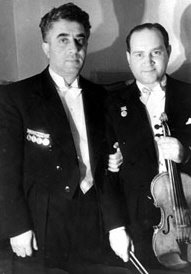
When you think of twentieth century Armenian composer Aram Khachaturian (1903-1978), what’s the first thing that comes to mind? Probably, the frenetic Sabre Dance, once called “one of the catchiest, most familiar—perhaps most maddening—tunes to come out of the 20th century.”
Khachaturian wrote the Sabre Dance for the final act of the 1942 ballet, Gayane. It quickly, perhaps surprisingly, made the jump into the world of popular music, covered by everyone from Woody Herman and James Galway to Vanessa-Mae. Appropriately, it was once featured even in television ads for the Buffalo Sabres hockey team.
But let’s dig deeper into Khachaturian’s music and listen to another piece: the Violin Concerto in D minor, completed in 1940 and dedicated to violinist David Oistrakh. Oistrakh advised Khachaturian (his close friend) throughout the composition process, eventually substituting his own cadenza for one written by the composer. Regarding the composition process, Khachaturian said,
I worked without effort. Sometimes my thoughts and imagination outraced the hand that was covering the staff with notes. The themes came to me in such abundance that I had a hard time putting them in some order.
Khachaturian’s Violin Concerto is infused with the colorful, modal sounds of Armenian folk music. It’s “fiddle music” in the best sense, at moments reveling in a joyfully exuberant sense of improvisation. For example, listen to the dialogue between the violin and clarinet in the first movement or the improvisational bassoon line which opens the lamenting second movement. We hear the influence of the Middle East, giving this music a distinctively different vibe. (Armenia borders both Iran and Turkey). To get a sense of this, listen to two short examples of Armenian folk music, here and here. Notice the sense of repetition and the way the rhythmic emphasis shifts to unexpected beats. Something similar happens in the final movement of the Violin Concerto.
The first movement’s soaringly romantic melody, reminiscent of Borodin, returns in the final movement, adding a circular dimension to the work. In between, the second movement, Andante sostenuto, takes us to a place of haunting melancholy. Towards the end of the movement, its quiet intensity gives way to a final, desperate, full-throated lament. The movement ends with a question mark.
In 1954 David Oistrakh made a studio recording with the Philharmonia Orchestra, conducted by Khachaturian. But let’s listen to Oistrakh’s spectacular 1965 live concert recording with Khachaturian conducting the Moscow Radio Symphony Orchestra:
[unordered_list style=”tick”]
- Find David Oistrakh’s recording with the Philharmonia Orchestra at iTunes, Amazon.
- Find the recording above on vinyl.
[/unordered_list]
